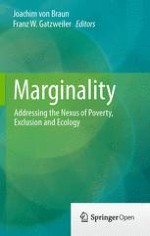5.1 Why Do We Map Marginality?
Maps are a powerful tool for presenting information in a way that is easily comprehensible by a non-specialist audience. Maps encourage visual comparison and make it easier to look for spatial trends, clusters or other patterns. Maps are therefore useful not only to governments and decision makers, but also to the local communities (Deichmann 1999, 3).
an involuntary position and condition of an individual or group at the margins of social, political, economic, ecological and biophysical systems, preventing them from access to resources, assets, services, restraining freedom of choice, preventing the development of capabilities, and eventually causing extreme poverty (Gatzweiler et al. 2011, 3).
5.2 Marginality Hotspots
5.2.1 Finding Proxies for Marginality Indicators on a Global Scale
Dimension I: | Economy |
|---|---|
Indicator: | Gross National Income (GNI) per capita PPP (current US$) |
Input: | World Bank Data 2010, visualized and geo-processed in ArcGIS (GIS software from ESRI (Environmental Systems Research Institute) |
Cut-off point: | US$1,005 GNI per capita World Bank definition for a low-income country (≤US$1,005) |
Source: | World Bank (compiled data from 2008 to 2010) |
Dimension II | Behavior and quality of life |
Indicator: | Prevalence of stunting among children under age five, by lowest available subnational administrative unit, varying years (FGGD) |
Input: | Global raster data layer with 5-arc-minutes resolution, data compilation by FAO including the prevalence of stunting, LandScan global population database and the percentage of stunted children under age 5 |
Cut-off point: | Prevalence of stunting among children under 5 >50 %, which is the FGGD definition for ‘very high’ stunting prevalence |
Source: | FAO 2007—the data are based on sources compiled by UNICEF, the map was created within the FGGD Digital Atlas |
Dimension III | Landscape design, land use and location/Infrastructure |
Indicator: | Travel time to major cities—a global map of accessibility |
Input: | Infrastructural data (based on data on populated places, cities, road networks, travel speeds, railway networks, navigable rivers, major water bodies, shipping lanes, borders, urban areas, elevation, and slope) |
Cut-off point: | More than 10 h travel time to the nearest city of 50,000 people or more |
Source: | |
Dimension IV | Ecosystems, natural resources and climate |
Indicator: | Global land area with soil constraints |
Input: | Soil depth, chemical status, fertility, drainage, texture, and miscellaneous constraints |
Cut-off point: | Soils that have ‘frequent severe’ and ‘very frequent severe’ soil constraints as well as ‘unsuitable for agriculture’ according to FAO 2007 classification |
Source: | FGGD, IIASA 2000 study on Global Agro-Ecological Zones (GAEZ) (van Velthuizen et al. 2007) |
Dimension V | Public domain and institutions |
Indicator: | Political stability, governance indicator |
Input: | perceptions of the likelihood that the government will be destabilized or overthrown by unconstitutional or violent means, including political violence or terrorism (Thomas 2009, 5) |
Cut-off point: | Lowest third-quantile |
Source: |
5.2.1.1 Economic Dimension
5.2.1.2 Demography and Quality of Life Dimension
5.2.1.3 Landscape Design and Infrastructure Dimension
5.2.1.4 Ecological Dimension
5.2.1.5 Public Domain Dimension
the traditions and institutions by which authority in a country is exercised. This includes (a) the process by which governments are selected, monitored and replaced; (b) the capacity of the government to effectively formulate and implement sound policies; and (c) the respect of citizens and the state for the institutions that govern economic and social interactions among them.
